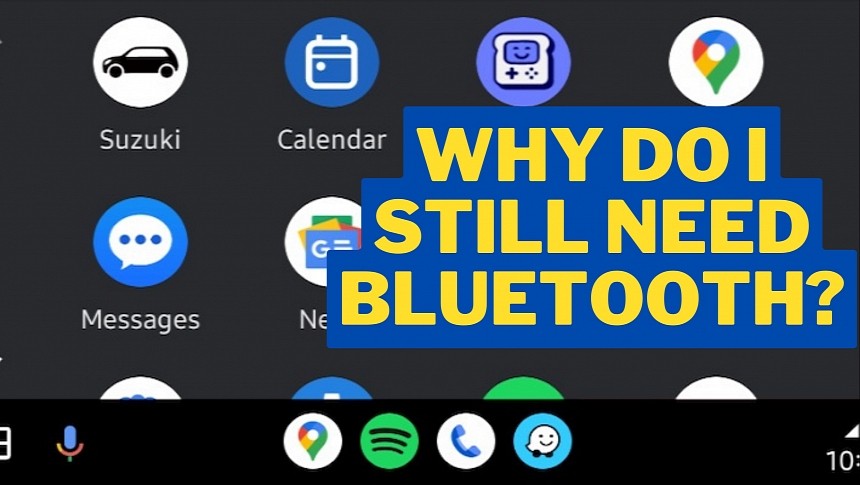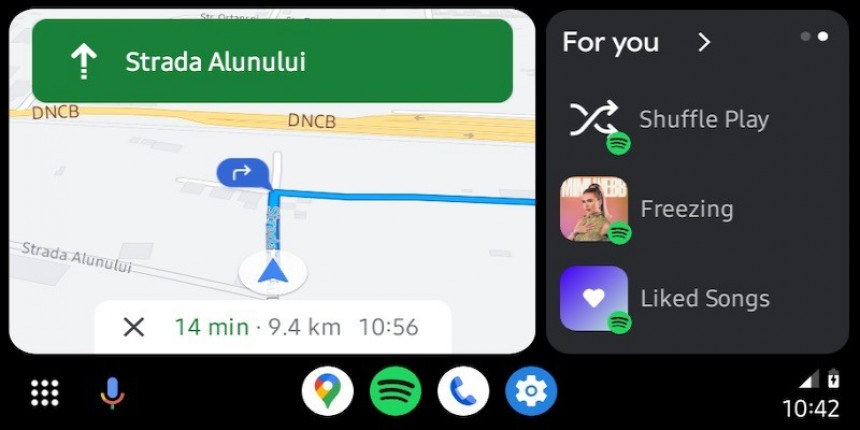Google designed Android Auto to be as straightforward as possible, so setting up the connection doesn’t take more than a couple of minutes, regardless of the connectivity method.
The wired version offers a plug-and-play experience, as you just connect the smartphone to the car using the integrated USB port, and Android Auto should launch the initial setup screen. The wireless version originally requires a cable connection as well, as it needs to conduct the first configuration with a direct connection between the phone and the head unit.
Once everything is configured correctly, you can run Android Auto without a cable if the car supports the wireless mode.
Regardless of the Android Auto version available in the car, the application always requires Bluetooth to be enabled on the smartphone. If you disable Bluetooth, Android Auto can't launch, so you might see a message on the screen to enable this wireless connection option to load the app.
Unsurprisingly, people are very confused over the need to keep Bluetooth on all the time, especially when running Android Auto via a cable. This doesn't make much sense, right? Given a cable connection is already available, why is Android Auto asking for Bluetooth?
First and foremost, you must understand how Bluetooth works. Android Auto uses this method to tell the head unit that the connection between the phone and the receiver is running. As such, the application can load correctly when the wireless mode is available.
Android Auto uses Bluetooth specifically for phone calls via the Hands-Free Protocol. By design, Bluetooth lacks the necessary bandwidth to render audio and video in the car, so Android Auto must turn to extra connection methods to work properly (hence the need for a cable or Wi-Fi in the case of a wireless connection).
In theory, Google could drop the need for Bluetooth entirely, but Android Auto continues to use it as a signal to the head unit that the connection is active. Most cars connect to phones via Bluetooth for phone calls and music playback, so Android Auto uses this option to handle the HFP.
If your car supports the wireless version of Android Auto, the music and the rest of the data (such as for running apps) are sent to the head unit using Wi-Fi Direct. This is why the Wi-Fi option must be enabled on your phone when using wireless Android Auto.
In summary, if your car supports only the wired mode, the cable connection is for music and apps, and Bluetooth is for calls. In the case of Android Auto wireless, the Bluetooth connection handles the voice calls, while the music and apps rely on Wi-Fi Direct.
The method might seem a little complicated at first, but it makes perfect sense, given the final purpose is providing a stable and reliable connection between the phone and the head unit.
Sure enough, many users found out the hard way that this isn't always the case. Connection problems are pretty common in the Android Auto world, and more often than not, the generic workarounds (which include trying out new cables, reinstalling Android Auto, or clearing the data and the cache) don't produce any improvements.
Many drivers discovered that starting from scratch in the car typically restores Android Auto if an app bug does not cause the broken connection. In other words, you need to delete the Bluetooth profile from the smartphone and the paired phone from the car and then reinitiate the Android Auto connection in the vehicle. In theory, this should help deal with potential connection problems between the phone and the media receiver, especially because Bluetooth doesn't always provide a flawless experience.
More often than not, disconnecting the phone from the head unit and shutting down Android Auto is the only way to use applications like Google Maps. The phone remains connected to the car via Bluetooth, and despite not having the navigation running on the larger screen on the dashboard, everything works properly on the mobile device.
Every now and then, users also experience bugs routing the phone call audio from the car's speakers to the phone. This happens primarily because of a corrupt Bluetooth connection, so following the steps above should help restore everything to the correct configuration.
Compared to Android Auto, the wired version of CarPlay does not require Bluetooth to be enabled all the time. On the other hand, Bluetooth is required for a wireless connection, as it's also used for handling phone calls.
In my experience with both apps, the wired mode is still the better option, especially because a cable provides the fastest connection between two devices. Obviously, finding the right cable to run Android Auto isn't easy, especially because even the original cords tend to misbehave every now and then, but once you build a flawless setup, everything should be much more stable.
Once everything is configured correctly, you can run Android Auto without a cable if the car supports the wireless mode.
Regardless of the Android Auto version available in the car, the application always requires Bluetooth to be enabled on the smartphone. If you disable Bluetooth, Android Auto can't launch, so you might see a message on the screen to enable this wireless connection option to load the app.
Unsurprisingly, people are very confused over the need to keep Bluetooth on all the time, especially when running Android Auto via a cable. This doesn't make much sense, right? Given a cable connection is already available, why is Android Auto asking for Bluetooth?
First and foremost, you must understand how Bluetooth works. Android Auto uses this method to tell the head unit that the connection between the phone and the receiver is running. As such, the application can load correctly when the wireless mode is available.
In theory, Google could drop the need for Bluetooth entirely, but Android Auto continues to use it as a signal to the head unit that the connection is active. Most cars connect to phones via Bluetooth for phone calls and music playback, so Android Auto uses this option to handle the HFP.
If your car supports the wireless version of Android Auto, the music and the rest of the data (such as for running apps) are sent to the head unit using Wi-Fi Direct. This is why the Wi-Fi option must be enabled on your phone when using wireless Android Auto.
In summary, if your car supports only the wired mode, the cable connection is for music and apps, and Bluetooth is for calls. In the case of Android Auto wireless, the Bluetooth connection handles the voice calls, while the music and apps rely on Wi-Fi Direct.
Sure enough, many users found out the hard way that this isn't always the case. Connection problems are pretty common in the Android Auto world, and more often than not, the generic workarounds (which include trying out new cables, reinstalling Android Auto, or clearing the data and the cache) don't produce any improvements.
Many drivers discovered that starting from scratch in the car typically restores Android Auto if an app bug does not cause the broken connection. In other words, you need to delete the Bluetooth profile from the smartphone and the paired phone from the car and then reinitiate the Android Auto connection in the vehicle. In theory, this should help deal with potential connection problems between the phone and the media receiver, especially because Bluetooth doesn't always provide a flawless experience.
More often than not, disconnecting the phone from the head unit and shutting down Android Auto is the only way to use applications like Google Maps. The phone remains connected to the car via Bluetooth, and despite not having the navigation running on the larger screen on the dashboard, everything works properly on the mobile device.
Every now and then, users also experience bugs routing the phone call audio from the car's speakers to the phone. This happens primarily because of a corrupt Bluetooth connection, so following the steps above should help restore everything to the correct configuration.
Compared to Android Auto, the wired version of CarPlay does not require Bluetooth to be enabled all the time. On the other hand, Bluetooth is required for a wireless connection, as it's also used for handling phone calls.
In my experience with both apps, the wired mode is still the better option, especially because a cable provides the fastest connection between two devices. Obviously, finding the right cable to run Android Auto isn't easy, especially because even the original cords tend to misbehave every now and then, but once you build a flawless setup, everything should be much more stable.

















